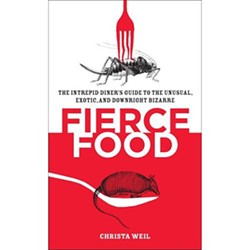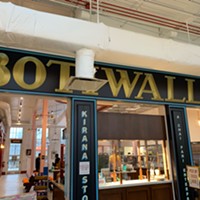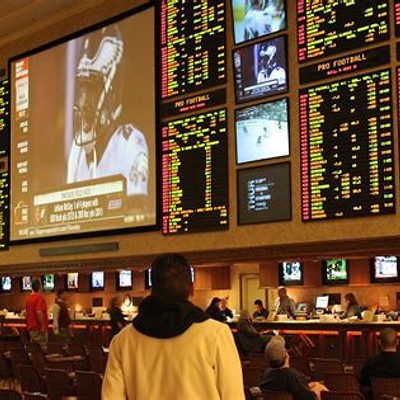Would you eat cloned beef? Or genetically engineered corn? What's the worst taste you've ever had in your mouth -- bad urchin at a sushi bar?
While the evening news is filled with reports on the new wave of "Franken-foods," current food and craft magazines are loaded with Halloween ghoulish grub and caldrons of bubbly green brew with floating kiwi eyeballs. But the really scary foods may already be located on the grocery store aisles or on menus across town.
In her recently published Fierce Food: The Intrepid Diner's Guide to the Unusual Exotic and Downright Bizarre (A Plume Book, 218 pages, $14), British author Christa Weil creates an easy and entertaining guide to some of the world's most perplexing food items. From Armadillo (which if undercooked can cause leprosy) to Yuba (which is recently set bean curd skin), Weil sets out to define some of the world's scariest foods. The book uses a handy key that includes a frowning face icon for revolting; a bomb to indicate that eating may cause pain, disease, and/or death; and a chicken head for "it tastes like chicken."
Weil writes of whale blubber being used as an Inuit pacifier and describes Japanese natto, a breakfast dish, as "one of the smelliest and most mucosal foods ever devised by the mind of man." Another stinky food is the Swedish surströmming, or rotten herring in a can. The after effects of picnicking on surströmming include "stinky fingers, bad breath, drunken stupor, vile burps, the possibility of small bones lodged in the throat." Yum. More please.
Weil suggests an evening of entertainment at a Chinese restaurant includes pulling the tendon on a chicken's foot to move the toes. Evidently your tablemates will reel with laughter.
While some of Weil's foods can not be found in the United States, many can. Whale blubber is banned in America unless you are a member of an indigenous people, but frozen natto is available at Asian markets. And chicken feet are fairly easy to come by at Asian markets and at Chinese restaurants. Try Dim Sum, Dragon Court, or Van Loi.
The Chinese typically have reasons to eat scary foods in much the same way medicine used to taste really bad. Forget Red Bull, Weil writes. The Chinese have Scorpion. Need to nourish your blood? Have some sliced sea cucumber -- that moving trash collector on the oceans' floor, in a brown sauce. Sea cucumber is available in Charlotte at Dragon's Court.
Some foods look cute but are deadly like the fly agaric, the white spotted red mushroom that frequently accompanies garden gnomes. Some foods just sound gross: human placenta. Yet others included on Weil's list do not seem to belong. Foofoo hardly sounds scary, nor is it made from anything frightening. Foofoo, an African dish, is a hot, pliable thickened porridge made from cassava starch. The authentic eating method is to pick up a dollop of warm foofoo, mold it into a small disk with an indentation, then scoop some stew and swallow it whole. (Foofoo is thought to be the forerunner of the Southern hoecake.) Foofoo (or fufu) can be found at Kilimanjaro Restaurant.
Weil also mentions honeysuckle, another less than fierce food ... unless of course you try to rid your garden of it. Those who grew up in the South may remember summers of tasting the nectar that clings to honeysuckle stamens.
For most Americans, as it has been for me, the scariest foods are those unexpectedly encountered on journeys. In central Australia, a tour guide bit the rear end off a honey ant he had dug up for a snack along a trail. I stuck with my bottled water and a Tim Tam cookie. Undoubtedly, our cultural patterns and mores require we eat certain foods and not others. Eating cat or dog in the West is unthinkable.
But on the second floor of a public market in a southern province of China, past the aluminum tubs of live eels, frogs, and fish, were long wooded containers filled with roasted dogs the size of Labradors. Beyond the dozens of dead dogs were rows of tiny skinned cats. Beneath these tables were bamboo cages filled with scrawny pathetic little cats meowing plaintively. Outside the market, snow monkeys filled a few metal cages. Weil reports that eating live monkey brains is an urban myth -- actually she wrote, "bullshit." But, I was told by many vendors while traveling in China that monkey brains were consumed there.
Let's face it. We consume brains right here in Charlotte. You can get cow brains with eggs at John's Country Kitchen. In fact, we Southerners love our offal, although I don't see chitterlings on many menus any more. And before any snowbirds read this and think they don't have the same offal taste, I've eaten derma (stuffed cow's intestines) on Long Island and mountain oysters (steers' testicles) in the West.
Branch out and you will find horse butcher shops in Paris and roasted kangaroo in Australia. In Lebanon, niffa is similar to Texas barbacoa, but uses lamb. The lamb's head is roasted slowly and steamed in a barbecue pit. Specialty shops sell this delicacy and customers come early. While the lamb brain and cheeks are the preferred portions, the eyeballs and tongue are popular, too.
So what was your scariest food? In China, living snakes are gutted to extract their gall bladders for a restorative wine. They say you won't have a cold for a year after drinking a shot glass sized portion. While I didn't get physically sick for more than a year after drinking this "wine," the "taste memory" still makes me shutter.
To contact Tricia regarding tips, compliments or complaints or to send notice of a food or wine event (at least 12 days in advance, please), opening, closing or menu change, fax Eaters' Digest at 704-944-3605, leave voice mail at 704-522-8334, ext. 136, or e-mail tricia.childress@creativeloafing.com.
Speaking of 4.67000
-

Behind The Camera
Oct 17, 2007 -
Scandal-Driven Tourism
Sep 26, 2007 -
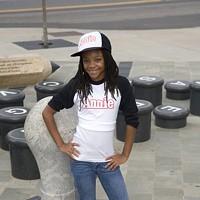
Jaida Benjamin
Aug 22, 2007 - More »
Latest in Food & Drink Features
More by Tricia Childress
-
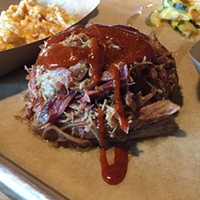
Seoul Food Meat Co's got soul
May 4, 2016 -
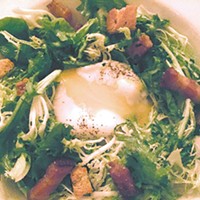
Aix en Provence flourishes in Myers Park
Apr 6, 2016 -
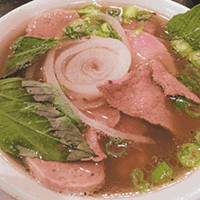
Pho and beyond at Saigon Bay Vietnamese Cuisine
Mar 2, 2016 - More »
Calendar
-

Haw River Wine Tasting @ Carolina Beer Temple.
- Wed., April 24, 5-7 p.m.
-

Haw River Wine Tasting @ Carolina Beer Temple.
-

TRIVIA THURSDAYS!!! @ Elizabeth Parlour Room
-

LIVE MUSIC FRIDAYS: TRACE CASANOVA @ Elizabeth Parlour Room at Hooligans FC
-

Charlotte Grilled Cheese Festival @ SouthEnd Station.
-
Bernardin's celebrates 1/2 year anniversary
A glimpse into this upscale Uptown location, complete with photos.
-
Vegan CEO Talks Meatless Mondays and Learning the Lifestyle
Planting the seed
-
Back of the Box: No Boil Classic Lasagne 5
Not having to boil the noodles rocks!

